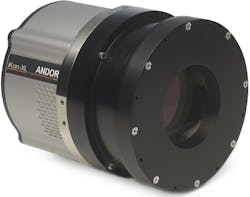Andor ColdSpace-cooled CCD deployed on Antarctica Bright Star Survey Telescope
The launch of the Andor (Belfast, Northern Ireland) iKon-XL Very Large Area (VLA) Astronomy CCD and its successful placement on a new planetary transit survey telescope on the Antarctic Plateau--the Bright Star Survey Telescope (BSST)--raises the prospect of more astronomy breakthroughs. The recent discovery of a trio of Earth-like exoplanets 39 light years away from Earth reinforces the need for more sensitive detection systems like this to survey the sky.
RELATED ARTICLE: Smoothed light allows direct exoplanet imaging
The iKon-XL VLA is purpose-designed to suit the long-exposure needs of astrophysical surveys that have, until now, been heavily reliant on conventional CCD cameras. Patent-pending ColdSpace technology cools the very large 16.8 Megapixel sensor to -100 degrees C, avoiding the need for liquid nitrogen or unreliable cryo coolers, while the large 12 micron pixels bring maximum photon capture. The result is ultralow noise performance and exceptional extended dynamic range that is complemented by up to 18-bit digitization and up to 95% QE performance from UV to NIR.
All of these technological advances are integrated within the robust, low-maintenance housing making it ideal for many experimental setups, including in remote astronomical observing sites. This was especially important for the new BSST in Antarctica, where the continuous darkness and large clear-sky fraction in the winter months greatly enhance the detection efficiency but the equipment has to survive temperatures as low as -80 C with the mean temperature of -56 C. Since the mechanical shutter of the iKon-XL must be above 0 C, Andor designed a special thermally controlled, titanium alloy shutter housing that maintains the temperature of the entire shutter mechanism to within 0.1 C
The BSST with its iKon-XL camera has now completed test observations, during which the optical design and temperature alignment tolerances were verified. During these trials, the BSST also successfully observed transiting events of two exoplanets, called HAT-P-3b and HAT-P-12b. Zhengyang Li, from the Nanjing Institute of Astronomical Optics and Technology, China, says, "the optical design and tolerance analysis guarantee the quality of BSST. The test observations reveal exceptionally clear single star images with a photometric precision of 3.5 mmag achieved for magnitude 11 stars with just 75 s exposures."
According to Colin Coates of Andor, an Oxford Instruments company, "Antarctica is a hugely promising site for planetary transit surveys, where the continuous darkness and the large clear-sky fraction in the winter months greatly enhance the detection efficiency. However, the extreme environment, with a mean temperature of -56 [degrees] C, brings huge technical challenges that must be overcome. Our custom-designed thermally-controlled shutter housing performed faultlessly and is essential to the success of the BSST."

Gail Overton | Senior Editor (2004-2020)
Gail has more than 30 years of engineering, marketing, product management, and editorial experience in the photonics and optical communications industry. Before joining the staff at Laser Focus World in 2004, she held many product management and product marketing roles in the fiber-optics industry, most notably at Hughes (El Segundo, CA), GTE Labs (Waltham, MA), Corning (Corning, NY), Photon Kinetics (Beaverton, OR), and Newport Corporation (Irvine, CA). During her marketing career, Gail published articles in WDM Solutions and Sensors magazine and traveled internationally to conduct product and sales training. Gail received her BS degree in physics, with an emphasis in optics, from San Diego State University in San Diego, CA in May 1986.
